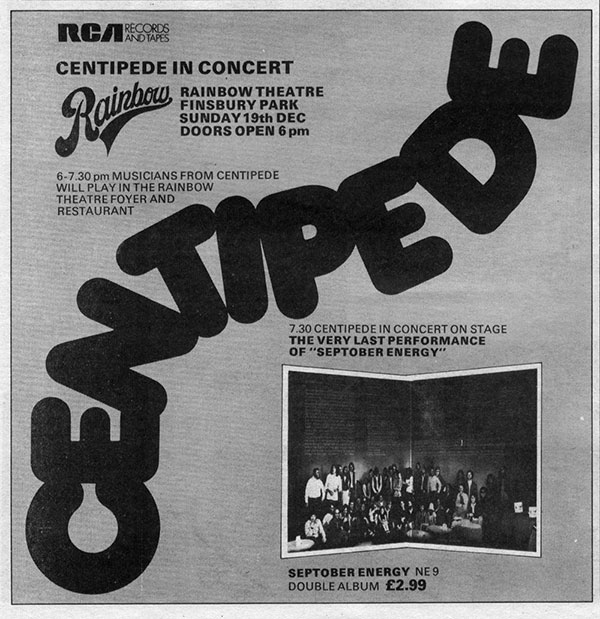
Centipede: Septober Energy – Expanded Edition( Cherry Red/Esoteric)
Centipede was a 50 piece orchestra convened and led by Keith Tippett from 1970 to 1971. Following Tippett’s death in 2020, Esoteric have worked with Julie Tippetts and Sony to remaster the original tapes of this album. There is no additional recorded material but there is a comprehensive booklet with notes, interviews and images.
The album has a somewhat hallowed status (and I am mindful to avoid the stock cliches) – partly due to the size of the band, partly due to the range of players from the free jazz and psychedelic music scene, and probably mainly due to the fact that Robert Fripp produced it. Consequently, Esoteric are to be congratulated for their restraint in releasing it as a double CD rather than as an overpriced vinyl bauble.
Tippett had already released two discs on a major label as leader and had guested on King Crimson sessions by the time he started to bring Centipede together. The birth of the band arose from the confluence of the strands of music making and the social networks that the Tippetts intersected, and also from the attitude of the record companies at the time. Whether this was sheer opportunism and a willingness to take a chance when they really didn’t know what was going to be the next big thing, or a golden age of music friendliness and enlightened curation is moot point. Certainly Tippett viewed the project as a chance to bring together musicians from a variety of genres and scenes – a utopian view which sometimes resulted in kitsch disasters when public school educated prog rockers relived their organ scholarships.
In a 2012 interview quoted in the notes, Tippett recalled the excitement of the RCA executives who had signed him and Julie:
they thought of us as the Johnny Dankworth and Cleo Lane of our generation
and adds:
Centipede was started very innocently. I would say 90% of the people were all friends, musically and socially. It was only some of the violin players who were recruited through a friend.
The band started with a 20 piece line up and then toured in the winter of 1970 before recoding the album in June 1971. There aren’t any live recordings that I am aware of, and memories are understandably patchy, so it isn’t clear whether the full 50 piece toured or whether it only came together in the studio. There certainly aren’t fifty people on the original centrefold photo. Violinist Wilf Gibson remembers:
No two performances were the same because there were great sections of it which were improvised. There were other parts that were like signposts, there was a filling in between signposts which were improvised. Some of it was written down but it was very free in places. You had these ostinato figures where you’re going round and round with improvisation going up against it.
Hence – without a conductor or orchestrated score – we are back to the big band formula of solos, riffs and beats to structure and organise such a large grouping of musicians. So although Septober Energy is the name of the piece played by Centipede, given that they didn’t seem to play anything else, it could equally be the name of the band.
This certainly shows in the studio version where Tippett and Fripp turn the piece into a suite. Bass player Roy Babbington recalls:
If your part came up then you were required to be at the studio. Conversely, if there were things you weren’t involved in you were expressly requested not to be at the studio. This was obviously for reasons of efficiency and economics. That side was policed by the Ronnie Scott’s guys. There were two or three of them and they were making sure the right people were in the right place at the right time. So we’d slide in to do our bit and we were then asked to vanish (laughs). Fripp was pretty efficient when it came to doing things like that.”
The review download which I had does not have any indexing and it will be a shame if the release does not have it, as some of the episodes in the piece are more compelling than others – there some beautiful subgroupings of percussion, voice and brass, but there are some larger groupings where, behind the solos, there is a lot of riffing and some lumbering rhythms which haven’t aged well.
That said, this is well curated and presented and a valuable addition to both the Tippett discography and the wider archive of British jazz in the ‘70s.
Stuart Riddle
